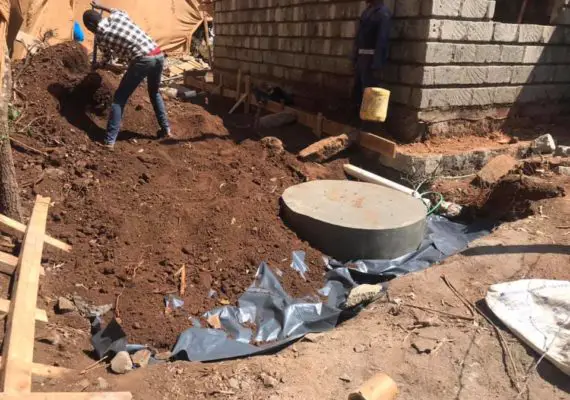What Is A Septic Drain Fields?
What Is A Septic Drain Fields?
Septic drain fields, also known as leach fields or leach drains, are underground facilities used to remove impurities and contaminants from the liquid that comes out of a septic tank after anaerobic digestion. This liquid contains organic materials that are broken down by a microbial ecosystem.
A septic drain field, septic tank and associated piping make up a septic system. The drain field typically consists of trenches with perforated pipes and porous material like gravel which is covered by a layer of soil to prevent animals and surface runoff from getting to the wastewater in the trenches.
The design of the drain field takes into account the volume of wastewater that needs to be disposed of and the long-term biochemical oxygen demand of the wastewater. The land set aside for the septic drain field is called the septic reserve area.
Sewage farms also dispose of wastewater through ditches and lagoons usually with little or no pre-treatment. These are more common in arid countries, where the waterflow on the surface can be used to irrigate and fertilize agricultural land.
Design Of Septic Drain Fields?
The process of percolation testing is a crucial step in determining the suitability of soil for a septic system.
This test is often required by health departments to ensure that the soil in the drain field is permeable enough for septic tank effluent to be effectively filtered and dispersed, while also being fine-grained enough to remove pathogenic bacteria and viruses.
The test is usually conducted by an engineer, soil scientist, or licensed designer, who works with the local governing agency to design a system that meets these criteria.
One alternative method for determining leach field sizing is by direct observation of the soil profile. During this process, the engineer evaluates various features of the soil, such as texture, structure, consistency, pores, and roots.
The goal of percolation testing is to ensure that the soil is permeable enough for septic tank effluent to percolate away from the drain field, but fine-grained enough to filter out pathogenic bacteria and viruses before they travel far enough to reach a water well or surface water supply.
Coarse soils, such as sand and gravel, can transmit wastewater away from the drain field before pathogens are destroyed. On the other hand, silt and clay effectively filter out pathogens, but allow very limited wastewater flow rates.
Percolation tests measure the rate at which clean water disperses through a disposal trench into the soil. However, several factors may reduce observed percolation rates when the drain field receives anoxic septic tank effluent.
Microbial colonies catabolizing soluble organic compounds from the septic tank effluent will adhere to soil particles and reduce the interstitial area available for water flow between soil particles. These colonies tend to form a low-permeability biofilm of gelatinous slime at the soil interface of the disposal trench.
Insoluble particles small enough to be carried through the septic tank will accumulate at the soil interface of the disposal trench; non-biodegradable particles like synthetic fiber lint from laundry, mineral soil from washing, or bone and eggshell fragments from garbage disposals will remain to fill interstitial areas formerly available for water flow out of the trench.
Cooking fats or petroleum products emulsified by detergents or dissolved by solvents can flow through prior to anaerobic liquefaction when septic tank volume is too small to offer adequate residence time, and may congeal as a hydrophobic layer on the soil interface of the disposal trench.
Rising groundwater levels may reduce the available hydraulic head (or vertical distance) causing gravitational water flow away from the disposal trench. Effluent initially flowing downward from the disposal trench might ultimately encounter groundwater or impermeable rock or clay requiring a directional shift to horizontal movement away from the drain field.
A certain vertical distance is required between the effluent level in the disposal trench and the water level applicable when the effluent leaves the drain field in order for gravitational force to overcome viscous frictional forces resisting flow through porous soil.
Effluent levels in the vicinity of the drain field will rise toward the ground surface to preserve that vertical distance difference if groundwater levels surrounding the drain field approach the level of effluent in the disposal trench.
Frozen ground may seasonally reduce the cross-sectional area available for flow or evaporation.
Inappropriate Wastes Of Septic Drain Fields
Microorganisms in septic tanks and drain fields have limited ability to break down petroleum products and chlorinated solvents, and cannot remove dissolved metals.
Some of these substances may be absorbed into the septic tank sludge or drain field soils, but they may also be diluted by other groundwater.
Cleaning products can also reduce the efficiency of drain fields. Laundry bleach, sanitizing or deodorizing chemicals can slow or stop microbial activity in the drain fields, and detergents, solvents and drain cleaners can transport fats into the drain field that can’t be broken down.
Maintenance Of Septic Drain Fields
A drain field that utilizes multiple disposal areas for the effluent from a single septic tank may be designed to allow for “resting” periods where one area is not being used.
During these periods, the nematode community in the resting area can continue to break down biofilm and fats, improving the overall capacity of the field by increasing the available soil interstitial area as organic material is oxidized.
This process may also improve the percolation rate, but it will likely not reach the original rate of the site.
![Advantages of Biodigester + How Biodigester Works [A Simple Guide]](https://www.hpdconsult.com/wp-content/uploads/2019/06/maxresdefault-1-570x400.jpg)
